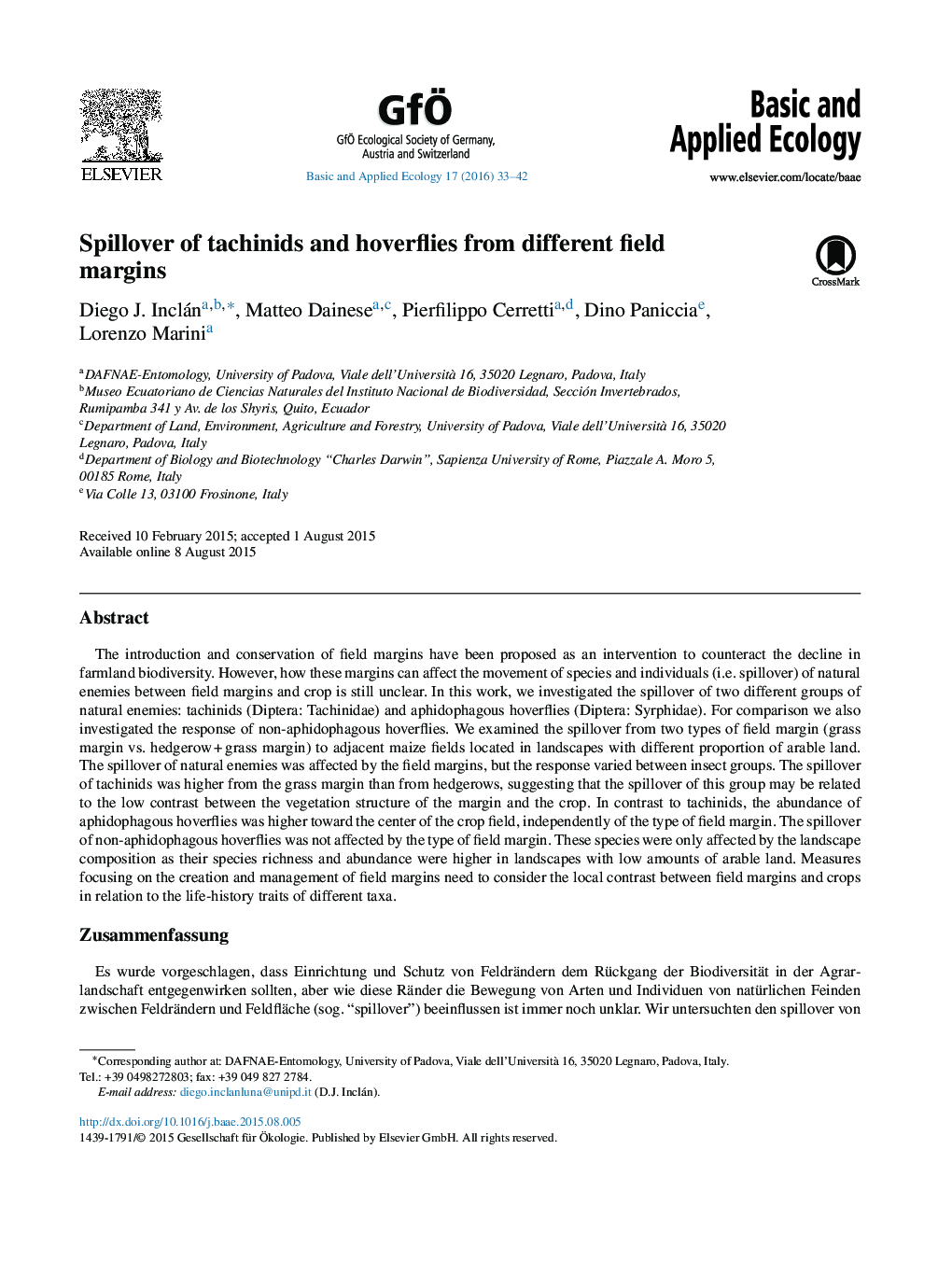| کد مقاله | کد نشریه | سال انتشار | مقاله انگلیسی | نسخه تمام متن |
|---|---|---|---|---|
| 4383866 | 1304371 | 2016 | 10 صفحه PDF | دانلود رایگان |
The introduction and conservation of field margins have been proposed as an intervention to counteract the decline in farmland biodiversity. However, how these margins can affect the movement of species and individuals (i.e. spillover) of natural enemies between field margins and crop is still unclear. In this work, we investigated the spillover of two different groups of natural enemies: tachinids (Diptera: Tachinidae) and aphidophagous hoverflies (Diptera: Syrphidae). For comparison we also investigated the response of non-aphidophagous hoverflies. We examined the spillover from two types of field margin (grass margin vs. hedgerow + grass margin) to adjacent maize fields located in landscapes with different proportion of arable land. The spillover of natural enemies was affected by the field margins, but the response varied between insect groups. The spillover of tachinids was higher from the grass margin than from hedgerows, suggesting that the spillover of this group may be related to the low contrast between the vegetation structure of the margin and the crop. In contrast to tachinids, the abundance of aphidophagous hoverflies was higher toward the center of the crop field, independently of the type of field margin. The spillover of non-aphidophagous hoverflies was not affected by the type of field margin. These species were only affected by the landscape composition as their species richness and abundance were higher in landscapes with low amounts of arable land. Measures focusing on the creation and management of field margins need to consider the local contrast between field margins and crops in relation to the life-history traits of different taxa.
ZusammenfassungEs wurde vorgeschlagen, dass Einrichtung und Schutz von Feldrändern dem Rückgang der Biodiversität in der Agrarlandschaft entgegenwirken sollten, aber wie diese Ränder die Bewegung von Arten und Individuen von natürlichen Feinden zwischen Feldrändern und Feldfläche (sog. “spillover”) beeinflussen ist immer noch unklar. Wir untersuchten den spillover von zwei unterschiedlichen Gruppen von natürlichen Feinden: Raupenfliegen (Diptera: Tachinidae) und aphidivore Schwebfliegen (Diptera: Syrphidae). Zum Vergleich betrachteten wir auch die nicht-aphidivoren Schwebfliegen. Wir untersuchten den spillover zwischen zwei Arten von Feldrändern (Grasrand und Hecke mit Grasrand) und den angrenzenden Maisfeldern, die in Landschaften mit unterschiedlichen Anteilen von Ackerflächen lagen. Der spillover der natürlichen Feinde wurde vom Feldrandtyp beeinflusst, aber die beiden Gruppen reagierten unterschiedlich. Der spillover der Raupenfliegen war vom Grasrand größer als von der Hecke, was nahelegt, dass der spillover bei dieser Gruppe eher mit dem geringen Kontrast zwischen der Vegetationsstruktur von Rand und Feldfrucht zusammenhängt. Dagegen war die Abundanz der aphidivoren Schwebfliegen zur Feldmitte hin erhöht, unabhängig vom Typ des Feldrands. Der spillover der nicht-aphidivoren Schwebfliegen wurde nicht durch den Typ des Feldrandes beeinflusst. Wir fanden nur einen Einfluss der Landschaft, da ihr Artenreichtum und ihre Abundanz in Landschaften mit geringem Ackerflächenanteil höher waren. Maßnahmen zur Schaffung und Pflege von Feldrändern müssen den lokalen Unterschied zwischen Feldrändern und Feldfrüchten in Bezug auf die Biologie der verschiedenen Taxa berücksichtigen.
Journal: Basic and Applied Ecology - Volume 17, Issue 1, February 2016, Pages 33–42
